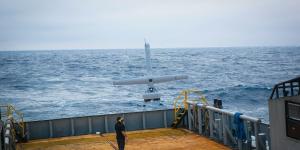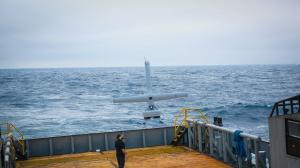Canadian Coast Guard Conducts Offshore Sea Trials of VTOL UAS with Shield AI and Kongsberg Geospatial
BVLOS endurance and Intelligence gathering trials of the V-BAT UAS were conducted in a variety of sea states and weather conditions
Sharing tech like the V-BAT strengthens strategic relationships and contributes to global stability.”
OTTAWA, ON, CANADA, January 26, 2022 /EINPresswire.com/ -- Kongsberg Geospatial announced today they successfully conducted sea trials of the Shield AI V-BAT Unmanned Aerial System (UAS) on behalf of the Canadian Coast Guard, operating from a small cargo vessel far offshore in international waters.— Brandon Tseng, Shield AI Co-founder
The Canadian Coast Guard is conducting trials of the long-endurance Vertical Take-of and Landing (VTOL) UAS surveillance system for possible deployment on Canadian Coast Guard Vessels under a project funded by Defence Research and Development Canada (DRDC). The Shield AI V-BAT aircraft was selected due to its unique ability to combine VTOL from the small confines aboard ship with the long endurance of a fixed-wing aircraft while carrying multiple sensors.
Kongsberg Geospatial teamed with Shield AI to deploy the V-BAT VTOL UAS for a 3-day sea trial in international waters in the Gulf of Mexico. The trials tested the capability of the aircraft to provide rapid launch and recovery, long endurance, and confined space take-off and landing from a moving vessel in a variety of weather conditions – both during the day, and at night. In addition to tracking and identifying other ships at long ranges, the flights conducted a variety of simulated missions designed to emulate real-world situations where the Canadian Coast Guard would use the drones. These included locating and tracking dye patches that simulated wreckage or oil spills, and locating life preservers in choppy seas and in a variety of weather conditions.
The V-BAT operators used Kongsberg Geospatial’s IRIS UxS software to safely pilot the aircraft at long ranges from the launch vessel. The IRIS software provides a comprehensive situational awareness picture of the operational airspace, data from a variety of sensors and data feeds – and shows the location of other aircraft and surface ships, as well as the launch vessel and the “ownship”, or drone being operated.
Sensor data feeds from the cameras and sensors carried by the UAS were ingested, at real-time, into the Kongsberg Geospatial Modular ISR Data Analysis and Storage system (MIDAS). The MIDAS system records video and other data from the UAS, and serves as a “mission intelligence coordinator” to view current and historical sensor feeds of the UAS within a temporal and geospatial context to increase sensor utilization effectiveness.
“While the sea conditions were perhaps a little rougher than expected, they were ideal for testing the launch and recovery capabilities of the V-BAT from a small ship under the kind of conditions you might expect during real operations”, said Rex Hayes, a retired US Navy and Coast Guard officer and the Director of Unmanned Systems at Kongsberg Geospatial. “We were also very pleased with the performance of IRIS and the MIDAS system when handling integrated sensor data feeds from extended missions”.
Trials like these are important to the continued health of the industry, according to Brandon Tseng, Shield AI’s cofounder and former U.S. Navy SEAL. "We love supporting our allies. It will take strong partnerships – technological, military, and economic – to maintain stability during challenging times. Sharing tech like the V-BAT strengthens strategic relationships and contributes to global stability. Our recent engagement with the Canadian Coast Guard and Kongsberg exemplifies our commitment to ensuring our allies have the cutting-edge technology and products they need!”
This series of endurance trials is the second set of flight trials of the Shield AI V-BAT conducted by the Canadian Coast Guard. The first series of flight trials were conducted at a UAS test range in Oklahoma last year to establish flight characteristics of the aircraft.
ENDS ###
About Kongsberg Geospatial: Based in Ottawa, Canada, Kongsberg Geospatial (https://kongsberggeospatial.com), developer of the TerraLens Geospatial SDK, creates precision real-time software for air traffic control and UxS and situational awareness. The Company’s products are primarily deployed in solutions for air-traffic control, Command and Control, and air defense. Over nearly three decades of providing dependable performance under extreme conditions, Kongsberg Geospatial has become the leading geospatial technology provider for mission-critical applications where lives are on the line. Kongsberg Geospatial is a subsidiary of Kongsberg Defence & Aerospace.
About Shield AI: Shield AI is a venture-backed company built around a team of proven executives, warfighters with relevant national security experience, and world-class AI engineers. The company is headquartered in San Diego, CA with satellite offices across the United States and abroad. Shield AI’s products and people are currently in the field actively supporting operations with the US Department of Defense and allies. The V-BAT, with its innovative, near-zero footprint vertical take-off and landing (VTOL) and long-endurance capabilities, is unlike any UAS on the market. Propelled by a single, ducted, thrust-vectored fan, it takes off and lands in the style of a SpaceX rocket. Its fully operational logistical footprint fits into the bed of a pickup truck or inside a Blackhawk helicopter, significantly reducing the total cost of capability. U.S. and international customers view the V-BAT as a flexible platform capable of performing Group 2 UAS to Group 4 UAS missions and beyond. For more information visit: Shield.AI
About the Canadian Coast Guard: Headquartered in Ottawa, the Canadian Coast Guard (https://www.ccg-gcc.gc.ca/index-eng.html) is the coast guard of Canada. Founded in 1962, the coast guard is tasked with marine search and rescue, communication, navigation and transportation issues in Canadian waters, such as navigation aids and icebreaking, marine pollution response and providing support for other Canadian government initiatives. The coast guard operates 119 vessels of varying sizes and 23 helicopters, along with a variety of smaller craft.
About DRDC: Based in Ottawa, Canada, Defence Research and Development Canada (https://www.canada.ca/en/defence-research-development.html) is the Department of National Defence’s and Canadian Armed Forces’ science and technology organization. DRDC develops and delivers new technical solutions and advice for not only DND/CAF, but also other federal departments, and the safety and security communities.
Christopher Ivey
Kongsberg Geospatial
+1 6132715501
email us here
Visit us on social media:
Twitter
LinkedIn
Canadian Coast Guard Sea Trials of the V-BAT


